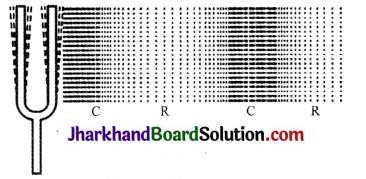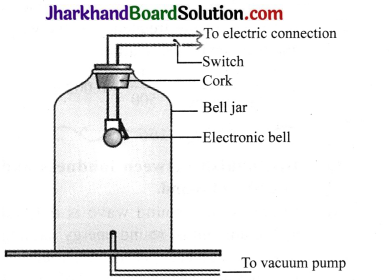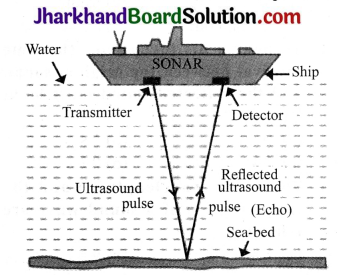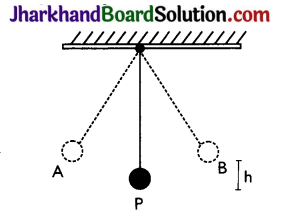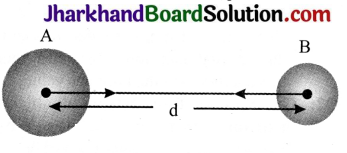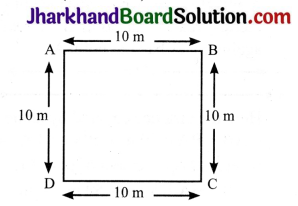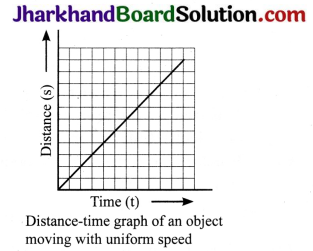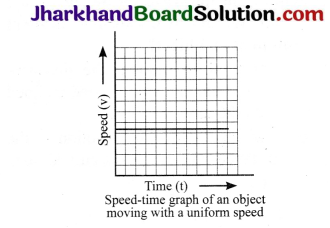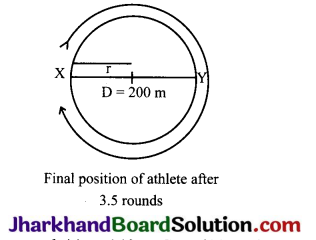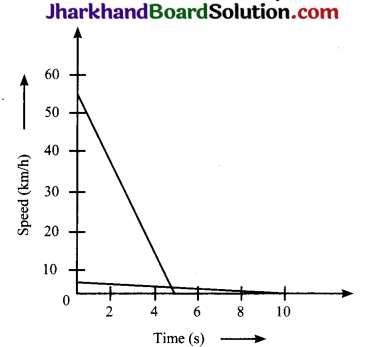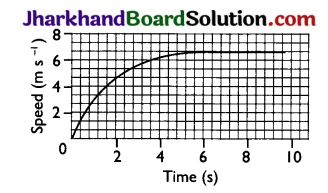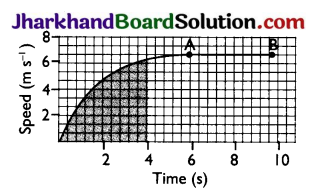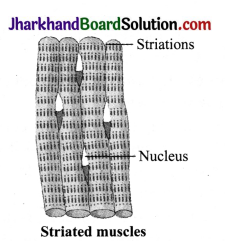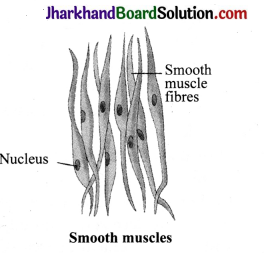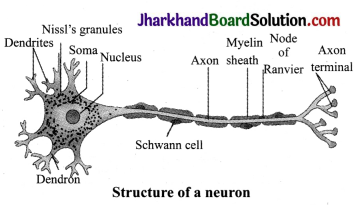JAC Board Class 10th English Solutions First Flight Chapter 1 A Letter to God
JAC Class 10th English A Letter to God Textbook Questions and Answers
Fill out the Money Order form given below using the clues that follow the form.
- Think about who you will send the money to, and how much. You might want to send money for a magazine subscription, or to a relative or a friend.
- Or you may fill out the form with yourself as sender and your partner as receiver. Use a part of your pocket money, and submit the form at the nearest post office to see how it’s done. See how your partner enjoys getting money by post!
- Notice that the form has three parts the Money Order form, the part for official use and the Acknowledgement. What would you write in the ‘Space for Communication’?

Now complete the following statements.
(i) In addition to the sender, the form has to be signed by the ……………..
(ii) The ‘Acknowledgement’ section of the form is sent back by the post office to the …………….. after the …………….. signs it.
(iii) The ‘Space for Communication’ section is used for …………….
(iv) The form has six sections. The sender needs to fill out …………… sections and the receiver ……………….
Answer:
(i) In addition to the sender, the form has to be signed by the receiver.
(ii) The ‘Acknowledgement’ section of the form is sent back by the post office to the sender after the receiver signs it.
(iii) The ‘Space for Communication’ section is used for writing message.
(iv) The form has six sections. The sender needs to fill out four sections and the receiver two.
Oral Comprehension Check (Page – 5)
Question 1.
What did Lencho hope for?
Answer:
Lencho hoped for good rain.
Question 2.
Why did Lencho say the raindrops were like ‘new coins’?
Answer:
Lencho’s crops were ready for harvest. However, they required a good downpour before harvesting. After a downpour, the crops will be good. That is why he compared the raindrops to ‘new coins’.
Question 3.
How did the rain change? What happened to Lencho’s fields?
Answer:
The rain was pouring down. But suddenly, a strong wind began to blow and very large hailstones began to fall along with the rain. Due to this, Lencho’s crops were totally destroyed.
![]()
Question 4.
What were Lencho’s feelings when the hail stopped?
Answer:
When the hail stopped, Lencho’s soul was filled with sadness.
Oral Comprehension Check (Page – 6)
Question 1.
Who or what did Lencho have faith in? What did he do?
Answer:
Lencho had unflinching faith in God. He wrote a letter to God expressing his need for hundred pesos so that he could sow his field again and live until the crop grew again.
Question 2.
Who read the letter?
Answer:
The postmaster read the letter when he received it from the postman.
Question 3.
What did the postmaster do then?
Answer:
In order to keep Lencho’s faith alive in God the postmaster collected money from his employees. He himself gave a part of his salary. He put the money in an envelope addressed to Lencho and signed it ‘God’.
Oral Comprehension Check (Page – 7)
Question 1.
Was Lencho surprised to find a letter for him with money in it?
Answer:
Lencho was not at all surprised to find a letter for him.
Question 2.
What made him angry?
Answer:
Lencho had demanded 100 pesos from God but he got only 70 pesos. That is why he got angry.
Thinking about the Text
Question 1.
Who does Lencho have complete faith in? Which sentences in the story tell you this?
Answer:
Lencho had complete faith in God. The following sentences in the story show this:
- But in the hearts of all who lived in that solitary house in the middle of the valley, there was a single hope: help from God.
- All through the night, Lencho thought only of his one hope: the help of God, whose eyes, as he had been instructed, see everything, even what is deep in one’s conscience.
- “God,” he wrote, “if you don’t help me, my family and I will go hungry this year.”
- God could not have made a mistake, nor could he have denied Lencho what he had requested.
- It said: “God: Of the money that I asked for, only seventy pesos reached me. Send me the rest, since I need it very much….”
Question 2.
Why does the postmaster send money to Lencho? Why does he sign the letter ‘God’?
Answer:
The postmaster sent money to Lencho in order to keep his faith alive in God. He signed the letter ‘God’ because he wanted to show that his money had been sent by God.
Question 3.
Did Lencho try to find out who had sent the money to him? Why/Why not?
Answer:
No, Lencho did not try to find out who had sent the money to him. This is because he never suspected that it could be anybody else other than God who would send him the money. Because he had full faith in God.
Question 4.
Who does Lencho think has taken the rest of the money? What is the irony in the situation? [Remember that the irony of a situation is an unexpected aspect of it. An ironic situation is strange or amusing because it is the opposite of what is expected.
Answer:
Lencho thought that the post office employees had taken the rest of the money. The irony of the situation was that the employees whom he called a “bunch of crooks” and suspected of taking some of the money were the same people who had contributed and sent him the money.
Question 5.
Are there people like Lencho in the real world? What kind of a person would you say he is? You may select appropriate words from the box to answer the question. greedy naive stupid ungrateful selfish comical unquestioning
Answer:
There might be a few people like Lencho in the real world. He is unquestioning. He is also naive.
Question 6.
There are two kinds of conflict in the story: between humans and nature, and between humans themselves. How are these conflicts illustrated?
Answer:
The conflict between humans and nature is illustrated by the destruction of Lencho’s crops by the hailstorm. Lencho had worked really hard on his fields and he was expecting good crop. But the nature turned violent and his crop was completely destroyed. The story also illustrates another conflict, i.e., between humans themselves.
The postmaster, along with the help of the other post office employees, sent Lencho the money that they could manage to collect. They were not related to Lencho in any manner. It was an act of kindness and selflessness on their part. Although they did a good deed, even then Lencho blamed them for taking away some amount of money. He called them “a bunch of crooks”. This shows that man does not have faith in his fellow humans.
Thinking about Language
Question 1.
Look at the following sentence from the story. Suddenly a strong wind began to blow and along with the rain very large hailstones began to fall. ‘Hailstones’ are small balls of ice that fall like rain. A storm in which hailstones fall is a ‘hailstorm’. You know that a storm is bad weather with strong winds, rain, thunder and lightning. There are different names in different parts of the world for storms, depending on their nature. Can you match the names in the box with their descriptions below, and fill in the blanks? You may use a dictionary to help you.
| gale | whirlwind | cyclone | hurricane | tornado | typhoon |
1. A violent tropical storm in which strong winds move in a circle: _ _c _ _ _ _
Answer:
cyclone
2. An extremely strong wind: _a _ _
Answer:
gale
3. A violent tropical storm with very strong winds: _ _ p _ _ _
Answer:
typhoon
4. A violent storm whose centre is a cloud in the shape of a funnel: _ _ _n_ _ _
Answer:
tornado
5. A violent storm with very strong winds, especially in the western Atlantic Ocean: _ _r_ _ _ _ _ _
Answer:
hurricane
6. A very strong wind that moves very fast in a spinning movement and causes a lot of damage: _ _ _ _l_ _ _ _
Answer:
whirlwind
II. Notice how the word ‘hope’ is used in these sentences from the story:
(a) I hope it (the hailstorm) passes quickly.
(b) There was a single hope: help from God.
In the first example, ‘hope’ is a verb which means you wish for something to happen. In the second example, it is a noun meaning a chance for something to happen.
Match the sentences in Column A with the meanings of ‘hope’ in Column B.
| A | B |
| 1. Will you get the subjects you want to study in college? I hope so. | – a feeling that something good will probably happen |
| 2. I hope you don’t mind my saying this, but I don’t like the way you are arguing. | – thinking that this would happen (It may or may not have happened). |
| 3. This discovery will give new hope to HIV/ AIDS sufferers. | – stopped believing that this good thing would happen |
| 4. We were hoping against hope that the judges would not notice our mistakes. | – wanting something to happen (and thinking it quite possible) |
| 5. I called early in the hope of speaking to her before she went to school. | – showing concern that what you say should not offend or disturb the other person: a way of being polite |
| 6. Just when everybody had given up hope, the fishermen came back, seven days after the cyclone. | – wishing for something to happen, although this is very unlikely |
Answer:
| A | B |
| 1. Will you get the subjects you want to study in college?I hope so. | – wanting something to happen (and thinking it quite possible) |
| 2. I hope you don’t mind my saying this, but I don’t like the way you are arguing. | – showing concern that what you say should not offend or disturb the other person: a way of being polite |
| 3. This discovery will give new hope to HIV/ AIDS sufferers. | – a feeling that something good will probably happen |
| 4. We were hoping against hope that the judges would not notice our mistakes. | – wishing for something to happen, although this is very unlikely |
| 5. I called early in the hope of speaking to her before she went to school. | – thinking that this would happen (It may or may not have happened.) |
| 6. Just when everybody had given up hope, the fishermen came back, seven days after the cyclone. | – stopped believing that this good thing would happen |
III. Relative Clauses
Look at these sentences.
(a) All morning Lencho – who knew his fields intimately – looked at the sky.
(b) The woman, who was preparing supper, replied, “Yes, God willing.”
The italicised parts of the sentences give us more information about Lencho and the woman. We call them relative clauses. Notice that they begin with a relative pronoun who. Other common relative pronouns are whom, whose and which.The relative clauses in (a) and (b) above are called non – defining, because we already know the identity of the person they describe. Lencho is a particular person, and there is a particular woman he speaks to.
We don’t need the information in the relative clause to pick these people out from a larger set.A non – defining relative clause usually has a comma in front of it and a comma after it (some writers use a dash (—) instead, as in the story). If the relative clause comes at the end, we just put a full stop.
Join the sentences given below using who, whom, whose, which as suggested.
1. I often go to Mumbai. Mumbai is the commercial capital of India, (which)
2. My mother is going to host a TV show on cooking. She cooks very well, (who)
3. These sportspersons are going to meet the President. Their performance has been excellent, (whose)
4. Lencho prayed to God. His eyes see into our minds, (whose)
5. This man cheated me. I trusted him. (whom)
Answer:
- I often go to Mumbai, which is the commercial capital of India.
- My mother, who cooks very well, is going to host a TV show on cooking.
- These sportspersons, whose performance has been excellent, are going to meet the President.
- Lencho, whose eyes see into our minds, prayed to God.
- This man, whom I trusted, cheated me.
IV. Using Negatives for Emphasis
We know that sentences with words such as no, not or nothing show the absence of something, of contradict something. For example:
(a) This year we will have no com. (Com will be absent)
(b) The hail has left nothing. (Absence of a crop)
(c) These aren’t raindrops falling from the sky, they are new coins. (Contradicts the common idea of what the drops of water falling from the sky are) But sometimes negative words are used just to emphasise an idea. Look at these sentences from the story.
(d) Lencho ……………. had done nothing else but see the sky towards the northeast. (He had done only this)
(e) The man went out for no other reason than to have the pleasure of feeling the rain on his body. (He had only this reason)
(f) Lencho showed not the slightest surprise on seeing the money. (He showed no surprise at all) Now look back at example (c). Notice that the contradiction in fact serves to emphasise the value or usefulness of the rain to the farmer.
Find sentences in the story with negative words, which express the following ideas emphatically.
1. The trees lost all their leaves.
2. The letter was addressed to God himself.
3. The postman saw this address for the first time in his career.
Answer:
- Not a leaf remained on the trees.
- It was nothing less than a letter to God.
- Never in his career as a postman had he known that address.
![]()
V. Metaphors
The word metaphor comes from a Greek word meaning ‘transfer’. Metaphors compare two things or ideas: a quality or feature of one thing is transferred to another thing. Some common metaphors are
- the leg of the table: The leg supports our body. So the object that supports a table is described as a leg.
- the heart of the city: The heart is an important organ in the centre of our body. So this word
is used to describe the central area of a city. In pairs, find metaphors from the story to complete the table below. Try to say what qualities are being compared. One has been done for you.
| Object | Metaphor | Question uality or Feature Compared |
| Cloud | Huge mountains, of clouds | The mass or ‘hugeness’ of mountains. |
| Raindrops | – | – |
| Hailstones | – | – |
| Locusts | – | – |
| – | – | An epidemic (a disease) that spreads very rapidly and leaves many people dead. |
| – | An ox of a man | – |
Answer:
| Object | Metaphor | Question uality or Feature Compared |
| Cloud | Huge mountains of clouds | The mass or ‘hugeness’ of mountains |
| Raindrops | New coins | Valuable like money |
| Hailstones | The frozen pearls | The resemblance in colour and hardness to a pearl |
| Locusts | A plague of locusts | An epidemic that spreads rapidly and leaves many people dead |
| Man | An ox of a man | A hardworking man |
Speaking
Question 1.
Have you ever been in great difficulty, and felt that only a miracle could help you? How was your problem solved? Speak about this in class with your teacher.
Answer:
Last year, we were returning from Agra by bus seeing the seventh wonder of the world – the Taj Mahal. In the dark night, after travelling about 50 kilometres at around 2 a.m., a lion was crossing the road. When the lion saw the bus, he jumped on it. We were terribly shocked to see this. All of us were frightened. We thought that it was the last day of our life. But all of a sudden, a miracle happened. A police van arrived. Seeing this panic, the policemen fired in the air. Hearing this, the lion ran away and we were saved. Really, it all happened due to the miracle of God.
Listening
Question 1.
Listen to the letter (given under ‘In This Lesson’) read out by your teacher/on the audiotape. As you listen fill in the table given below.
| The writer apologises (says sorry) because | |
| The writer has sent this to the reader | – |
| The writer sent it in the month of | – |
| The reason for not writing earlier | – |
| Sarah goes to | – |
| Who is writing to whom? | – |
| Where and when were they last together? | – |
Answer:
| The writer apologises (says sorry) because | he has not written to her since a long time |
| The writer has sent this to the reader | as birthday card |
| The writer sent it in the month of | September 2005 |
| The reason for not writing earlier | due to busy schedule |
| Sarah goes to | ‘Little Feet’ School |
| Who is writing to whom? | Jaya is writing to Arti |
| Where and when were they last together? | At Bengaluru, last year |
Writing
Question 1.
Lencho suffered first due to drought and then by floods. Our country is also facing such situations in the recent years. There is flood and there is drought. There is a need to save water through water harvesting. Design a poster for your area on how to save water during summer and when it is available in excess.
Answer:
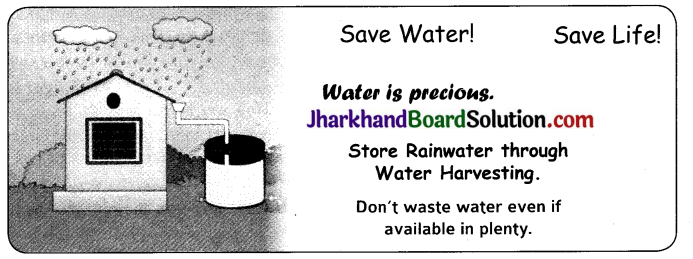
JAC Class 10th English A Letter to God Important Questions and Answers
I. Short Answer Type Question (20 – 30 words & 2 marks each)
Question 1.
Why was Lencho angry when he received the letter?
Answer:
Lencho was very angry after receiving the letter because there were only seventy pesos in the envelope, which was much less than what he had demanded.
Question 2.
How did the postmaster help Lencho?
OR
What did the postmaster do to keep the faith of Lencho alive?
Answer:
The postmaster collected money from the post office employees and put it in an envelope addressed to Lencho with a letter containing ‘God’. He just did this to keep the faith of Lencho alive in God.
Question 3.
Where was Lencho’s house situated? Why did he sit seeing the sky?
Answer:
Lencho’s house was situated on the crest of a low hill in the valley. The whole day he sat seeing the sky because he knew that his fields needed downpour or at least a shower and he was waiting to see the signs of rain.
![]()
Question 4.
What were Lencho’s feelings when the hailstorm stopped?
Answer:
Lencho was filled with utter sadness when the hailstorm stopped. He was troubled to see the harvest which was totally destroyed. Nothing was left in the fields.
Question 5.
How did Lencho’s hope change to despair?
Answer:
Lencho was waiting for a shower of rain that his field needed. But his hope for good rain was shattered when the wind changed into hailstorm. It destroyed his harvest completely. So, Lencho’s hope changed to despair as his family would face starvation.
II. Short Answer Type Questions (40 – 50 words & 3 marks each)
Question 1.
In what manner did the rain come and how did Lencho feel about it?
Answer:
Lencho’s wife was preparing food and the boys were working in the field. It was during the meal, when raindrops started falling as Lencho had predicted earlier. He went out to take the pleasure of feeling the rain on his body. Raindrops were like the new coins for Lencho.
Question 2.
What help is being referred to in the line, ‘But in the hearts of all who lived in that solitary house in the middle of the valley, there was a single hope’? Why?
Answer:
The com fields were completely destroyed by the hailstones. Lencho would have no com that year. He was devastated at the loss and thought that no human could help him with this kind of loss. Therefore, he addressed to God asking for his aid as it would be only God’s help that could compensate for his losses.
Question 3.
What address did Lencho write on the letter? How was it sent to God?
Answer:
Lencho was a firm believer in God. When he encountered huge loss in his crop for that year, he pondered over writing a letter to God. He wrote ‘To God’ on the envelope and put the letter into the mailbox after placing a stamp on it.
Question 4.
What was the reaction of the postmaster when the postman showed him the letter to God?
Answer:
The postman received the letter to God and upon seeing the address, he laughed heartily. He went to his boss, the postmaster and showed it to him. The postmaster too laughed heartily > but he immediately turned serious. He was impressed with the farmer’s faith in God. He could utter only such words, “What a faith!”
Question 5.
Why did Lencho go earlier than usual to the post office the following Sunday?
Answer:
Since Lencho had an unrelenting faith in God and his mercy, he was expecting a reply from him. Therefore, he went to the post office a bit earlier than usual. The postman handed over the letter to Lencho and the postmaster was feeling a sense of contentment doing a good deed.
Question 6.
Discuss the irony in the chapter.
Answer:
The end of the story is rather ironical. Impressed with the utter faith of Lencho in God, the postmaster collected a sum of seventy pesos from his employees and contributed a part of his salary. He did not want to shake his faith in God. However, his great act of charity was not recognised and appreciated by Lencho, the man who received the help. Contrary to it, the post office employees were ironically called ‘a bunch of crooks’ by the farmer.
Question 7.
Why did Lencho not want the money to be sent through mail by God?
Answer:
Lencho had asked in his first letter for hundred pesos from God. In return, he got seventy pesos and made a judgement that thirty pesos were taken out by the post office employees. Therefore, he requested God not to send money through post office as in his opinion post office employees were ‘a bunch of crooks’.
Question 8.
How did the hailstorm shatter Lencho’s hope and dreams?
Answer:
The rain that was welcomed by Lencho, all of a sudden, changed into hailstorm. It rained for an hour. The whole com field was turned white due to snow. It was totally destroyed. There was not a leaf left on the trees. The hail destroyed everything. Lencho’s hope was completely downcast and his dreams were crushed to the ground.
III. Long Answer Type Questions (100 – 120 words & 5 marks each)
Question 1.
The postmaster represents the people who still believe in helping others. Mention those values of the postmaster which you would like to emulate.
Answer:
The postmaster represents the people who still believe in helping others. To keep Lencho’s faith alive in God, the postmaster took the help of his employees and collected the amount, He had love and empathy towards Lencho knowing his situation. He was compassionate and even did not let Lencho know that they were helping him. He sent the amount to Lencho in the name of God. In a nutshell, the postmaster possessed values like helping others, loving nature and compassionate.
![]()
Question 2.
Lencho had unflinching faith in God. Did he have the same faith in humans too? Write about his attitude towards God and human taking instances from the story.
Answer:
When Lencho’s crop was destroyed by the hailstorm, he wrote a letter to God asking for hundred pesos as a compensation for his loss. The postmaster, seeing his faith in God, collected seventy pesos to help him as he did not want the farmer’s faith to be shaken. After receiving the letter, Lencho thought that the post office employees took out thirty pesos from the share of hundred pesos which he had asked for from God. In his second letter to God, he asked God not to send money through mail as he said that the employees there, were ‘a bunch of crooks’. This shows Lencho’s attitude towards God and human. He had complete faith in God but did not have any faith in human.
Question 3.
Why did Lencho want the rain to come? How did the same rain change the face of Lencho’s field?
Answer:
Lencho was a farmer who was waiting eagerly for the rain as his crops needed a downpour, a shower. The rain did come. Lencho felt as if they were new coins. The big drops of rain, according to him, were ten cent pieces and the little ones were that of five. He was quite satisfied with the rainfall. Suddenly, the strong wind began to blow and with the rain very large hailstones began to fall. He hoped for it to pass quickly but it did not happen. It destroyed his crop completely. The rain, which till then was a hope for better future, changed. It shattered all his hopes and changed the face of his field. The whole standing crop was ruined.
Question 4.
You are Lencho. Write a letter to your friend telling him about the destruction of your crops, the letter you wrote to God and the reply with money you received. Express your reaction about the post office employees also.
Answer:
43, Free Lane
Kathmandu Nepal
20th Jan., 20XX
Dear Poko
Hope you are hale and hearty. This year is not going to be so good for me as the last one. The rains have ruined all my harvest. We have nothing to eat. So, I thought of writing a letter to God and ask him to send 100 pesos. And do you know Poko, I got the money but not the amount I had asked for. Thirty pesos were missing. I have doubt on the post office employees. I wrote to God again and requested for the remaining amount of money. I’m sure He will definitely send the remaining amount.
I’m waiting for a reply from God.
With love
Lencho
Question 5.
Lencho seemed to be an impulsive man who felt suddenly elated at the rainfall and later became sad to see the destruction which the rain had caused. Did he lack tolerance? Did he not have the courage to face the challenges of life? Elucidate it discussing the values one must possess to face any type of situation.
Answer:
Lencho seems to be an impulsive man, as he had hoped for a good rain. But he was disappointed after seeing the destroyed crop. He had tolerance and the courage to face the challenges of life. His firm faith in God made him to write a letter and the tolerance in
him kept him waiting for the reply. He accepted seventy pesos and again wrote a second. letter demanding for the rest of the amount. In the same manner, one must face the situation courageously and be tolerant to overcome the difficulty.
Question 6.
Lencho addresses the post office employees as a ‘bunch of crooks’. Why? Give reasons in support of your answer.
Answer:
The hailstones ruined Lencho’s crop and made him helpless. So he thought of writing a letter to God to help him for his destructed crop. Lencho requested God to send hundred pesos. The postmaster sent him 70 pesos. Lencho became angry when he counted the money. He thought that 30 pesos were taken by the post office employees. He again wrote a letter to God to send thirty pesos more. He also told that the remaining money should not be sent through post office because its employees were a ‘bunch of crooks.’
![]()
Question 7.
“God,” he wrote, “if you don’t help me, my family and I will go hungry this year. I need a hundred pesos in order to sow my field again and to live until the crop comes because the hailstorm…” On the basis of this passage, explain how Lencho had unflinching faith in God? Also discuss what does the author want to highlight through this?
Answer:
Lencho was a farmer. He was expecting a good crop this year but all of a sudden the hailstorm came and destroyed his crop completely. So, Lencho got frustrated and he had nothing left with him to sustain his family. There was no way out for him. But he had unflinching faith in God. That is why he wrote a letter to God and demanded 100 pesos as a compensation for his loss. He demanded this money in order to sow his field again and also to save his family. All these things show Lencho’s extreme faith in God. He did not know about ifs and buts and concentrated his mind only on God. If you do not find a way out and surrender before God then God will certainly help you. He will surely show you the path to success or the way to 1 your destined place. This way we can say that Lencho’s extreme faith in God will certainly help him in getting his desired thing. And ultimately he got what he desired, Through this, the author wants to highlight the extreme and unflinching faith of Lencho in God. We should also cultivate such faith and conviction in God.
Question 8.
It said “God : Of the money that I asked for, only seventy pesos reached me. Send me the rest, since I need it very much. But don’t send it to me through the mail because the post office employees are a bunch of crooks.” What does Lencho want to say though this?
Answer:
Lencho was a firm believer of God. He had faith only in the existence of God. Apart from J God, he did not believe anybody. The hailstorm completely ruined his crops. So, he became too much frustrated. Hence, he wrote a letter to God and demanded hundred pesos. In response to that he got seventy pesos. After getting that he wrote another letter to God and demanded the remaining thirty pesos.
Except God, he did not believe anybody. But he also r wrote the letter that the remaining amount should be sent through only the mail and not through the post office employees because they were a ‘bunch of crooks’. Through this Lencho only wanted to show that nobody is reliable in this world. We can’t depend solely on anybody. It is only God whom we can rely and have faith in Him. God is not only the creator and destroyer but the sustainer too. This is what Lencho wanted to say through this.
Reference To Context
Read the extracts given below and answer the questions that follow:
Question 1.
THE house – the only one in the entire valley sat on the crest of a low hill. From this height one could see the river and the field of ripe com dotted with the flowers that always promised a good harvest. The only thing the earth needed was a downpour or at least a shower. Throughout the morning Lencho – who knew his fields intimately – had done nothing else but see the sky towards the north – east.
Choose the correct option:
(a) Whose house sat on the crest of a low hill?
(i) Lencho’s
(ii) Postmaster’s
(iii) Postman’s
(iv) Lencho’s workers
Answer:
(i) Lencho’s
(b) What could one see frow the hill?
(i) River
(ii) Field of ripe com
(iii) Both (i) and (ii)
(iv) None of these
Answer:
(iii) Both (i) and (ii)
(c) The only thing the earth needed was a.
(i) heat
(ii) downpour
(iii) river water
(iv) none of these
Answer:
(ii) downpour
(d) What did Lencho look at towards the north – east?
(i) Sky
(ii) Sun
(iii) Moon
(iv) Stars
Answer:
(i) Sky
(e) Find out a word from the passage similar in meaning to ‘freckled.’
(i) plain
(ii) dotted
(iii) horizontal
(iv) vertical
Answer:
(ii) dotted
![]()
Question 2.
The woman who was preparing supper, replied, “Yes, God willing”. The older boys were working in the field, while the smaller ones were playing near the house until the woman called to them all, “Come for dinner”. It was during the meal that, just as Lencho had predicted, big drops of rain began to fall. In the north – east huge mountains of clouds could be seen approaching.
Choose the correct option:
(a) Who were working in the field?
(i) The children
(ii) The older boys
(iii) The women
(iv) All of these
Answer:
(ii) The older boys
(b) What were the smaller ones doing?
(i) They were playing near the house.
(ii) They were reading in the school.
(iii) They were only making a noise in the house.
(iv) None of these
Answer:
(i) They were playing near the house.
(c) In which direction could huge mountains of clouds be seen approaching?
(i) South – east
(ii) West – south
(iii) North – east
(iv) East – west
Answer:
(iii) North – east
(d) For what did the woman call the children?
(i) For playing
(ii) For dinner
(iii) For reading
(iv) Didn’t call
Answer:
(ii) For dinner
(e) Find out a word from the passage similar in meaning to ‘forecast.’
(i) predict
(ii) succeed
(iii) hindsight
(iv) approach
Answer:
(i) predict
Question 3.
With a satisfied expression he regarded the field of ripe com with its flowers, draped in a curtain of rain. But suddenly a strong wind began to blow and along with the rain very large hailstones began to fall. These truly did resemble new silver coins. The boys, exposing themselves to the rain, ran out to collect the frozen pearls.
Choose the correct option:
(a) What was draped in a curtain of rain?
(i) The field of paddy
(ii) The field of ripe com with its flowers
(iii) The field of green vegetables
(iv) None of these
Answer:
(ii) The field of ripe com with its flowers
(b) What happened suddenly?
(i) A strong wind began to blow.
(ii) The children started crying.
(iii) The children started playing in the ground.
(iv) Nothing happened.
Answer:
(i) A strong wind began to blow.
(c) The hailstones resemble to.
(i) new gold coins
(ii) new silver coins
(iii) both (i) and (ii)
(iv) none of these
Answer:
(ii) new silver coins
(d) What did the boys start collecting?
(i) The boys started collecting the frozen pearls.
(ii) The boys started collecting money.
(iii) The boys started collecting the gold coins.
(iv) None of these
Answer:
(i) The boys started collecting the frozen pearls.
(e) Find out a word from the passage opposite in meaning to ‘suddenly.’
(i) quickly
(ii) swiftly
(iii) expectedly
(iv) unexpectedly
Answer:
(iii) expectedly
![]()
Question 4.
All through the night, Lencho thought only of his one hope: the help of God, whose eyes, as he had been instmcted, see everything, even what is deep in one’s conscience. Lencho was an ox of a man, working like an animal in the fields, but still he knew how to write. The following Sunday, at daybreak, he began to write a letter which he himself would carry to town and place in the mail. It was nothing less than a letter to God.
Choosethe correct option:
(a) What did Lencho think about all through the night?
(i) Only about the help of postmaster
(ii) Only about the help of his master
(iii) Only about the help of God
(iv) None of these
Answer:
(iii) Only about the help of God
(b) When did Lencho plan to write a letter?
(i) On the following Sunday
(ii) On the following Monday
(iii) On the following Thursday
(iv) On the following Friday
Answer:
(i) On the following Sunday
(c) …………….. was an ox of a man.
(i) Lencho
(ii) His wife
(iii) Ills children
(iv) None of these
Answer:
(i) Lencho
(d) To whom did Lencho write a letter?
(i) To his relatives
(ii) To his friends
(iii) To God
(iv) None of these
Answer:
(iii) To God
(e) Find out a word from the passage similar in meaning to ‘advised.’
(i) uniformed
(ii) instructed
(iii) deviated
(iv) succeeded
Answer:
(ii) instructed
Question 5.
One of the employees, who was a postman and also helped at the post office, went to his boss laughing heartily and showed him the letter to God. Never in his career as a postman had he known that address. The postmaster a fat, amiable fellow also broke out laughing, but almost immediately he turned serious and, tapping the letter on his desk, commented, “What faith! I wish I had the faith of the man who wrote this letter. Starting up a correspondence with God!”
Choose the correct option:
(a) Which address had the postman never known in his career?
(i) His home address
(ii) Post office address
(iii) God’s address
(iv) Hospital address
Answer:
(b) Which thing of the farmer did the postman wish for?
(i) Farmer’s crops
(ii) Farmer’s faith
(iii) Farmer’s vast fields
(iv) Farmer’s son
Answer:
(ii) Farmer’s faith
(c) The postmaster was laughing heartily but immediately he turned .
(i) serious
(ii) angry
(iii) pale
(iv) none of these
Answer:
(i) serious
(d) How was the postmaster?
(i) weak
(ii) fat
(iii) thin
(iv) none of these
Answer:
(ii) fat
(e) Find out a word from the passage similar in meaning to ‘communication.’
(i) familiar
(ii) difference
(iii) correspondence
(iv) withdrawal
Answer:
(iii) correspondence
Question 6.
The following Sunday Lencho came a bit earlier than usual to ask if there was a letter for him. It was the postman himself who handed the letter to him while the postmaster, experiencing the contentment of a man who has performed a good deed, looked on from his office. Lencho showed not the slightest surprise on seeing the money; such was his confidence – but he became angry when he counted the money. God could not have made a mistake, nor could he have denied Lencho what he had requested.
Choose the correct option:
(a) Why did Lencho become angry?
(i) Because he was beaten.
(ii) Because he was ill – treated.
(iii) Because he did not get 100 pesos from God.
(iv) Because he lost his money.
Answer:
(iii) Because he did not get 100 pesos from God.
(b) What was the belief of Lencho?
(i) God cannot make mistake in sending the money.
(ii) God can only give us blessings.
(iii) God can do nothing for him.
(iv) None of these.
Answer:
(i) God cannot make mistake in sending the money.
(c) The postmaster experienced the ………….. of a man who has performed a good deed.
(i) contentment
(ii) dissatisfaction
(iii) worthiness
(iv) capacity
Answer:
(i) contentment
(d) Who handed over the letter to Lencho?
(i) The postmaster
(ii) The postman
(iii) Lenchos son
(iv) Lencho’s wife
Answer:
(ii) The postman
(e) Find out a word from the passage similar ¡n meaning to ‘satisfaction.’
(i) contentment
(ii) dissatisfaction
(iii) fumble
(iv) deep
Answer:
(i) contentment
![]()
Question 7.
Immediately, Lencho went up to the window to ask for paper and ink. On the public writing- table, he started to write, with much wrinkling of his brow, caused by the effort he had to make to express his ideas. When he finished, he went to the window to buy a stamp which he licked and then affixed to the envelope with a blow of his fist. The moment the letter fell into the mailbox the postmaster went to open it. It said: “God: Of the money that I asked for, only seventy pesos reached me. Send me the rest, since I need it very much. But don’t send it to me through the mail because the post office employees are a ‘bunch of crooks’.
Choose the correct option:
(a) For what purpose did Lencho go up to the window immediately?
(i) To talk to his wife
(ii) To ask for paper and ink
(iii) To talk to his children
(iv) None of these
Answer:
(ii) To ask for paper and ink
(b) Where did Lencho start writing?
(i) On the public writing table
(ii) On the window of the post office
(iii) On the roof of the post office
(iv) None of these
Answer:
(i) On the public writing table
(c) Lencho demanded rest of the money from .
(i) post office employees
(ii) God
(iii) his relatives
(iv) none of these
Answer:
(ii) God
(d) Whom did Lencho call ‘a bunch of crooks’?
(i) The family members
(ii) The postmaster only
(iii) The post office employees
(iv) None of these
Answer:
(iii) The post office employees
(e) Find out a word from the passage similar in meaning to ‘fastened’.
(i) disjointed
(ii) affixed
(iii) unhooked
(iv) broken
Answer:
(ii) affixed
A Letter to God Summary
A Letter to God About the Author
- Gregorio Lopez Y Fuentes (July 11, 1897 – January 13, 2002) was bom in Lanzarote in the Canary Islands.
- He was a fisherman.
- At the age of 10, he first went to sea as a deck boy along with his father.
- At the age of 22, he migrated permanently to Cuba.
- ‘A Letter to God’ is considered to be one of his best stories.
- He died of cancer in Cojimar in 2002.
A Letter to God Gist of the Lesson
‘A Letter To God’ is a story of extreme faith in God. In this story, the writer has tried to depict the faith of a poor and simple farmer; Lencho in God. Lencho was an honest and hardworking farmer. He lived on a low hill along with his family. He was expecting a good harvest that season. All of a sudden, the hailstorm came and destroyed his crop completely.
He was quite hurt. He wrote a letter to God and demanded 100 pesos. He asked God to send him money. The postmaster saw the letter and laughed loudly. Then he got serious and decided to help Lencho. He collected some money. He put it inside the envelope and sent it to Lencho. Lencho came to the post office to check his mail. The post office people gave him the envelope.
Lencho opened the envelope. He took out the money and counted it. He found that it was less than what he had asked for. He got angry. He wrote another letter to God. He asked God to send him the rest of the money. But he asked God not to send the money through the mail because the post office employees were a ‘bunch of crooks.’
A Letter to God Summary
Brief Introduction: There was only one house in the entire valley. It was located on the crest of a low hill. The field of the ripe com was dotted with flowers. It was a sign of good harvest. Lencho, a fanner was just looking at the sky in the hope of good rain.
Activities around the house: The woman was preparing supper. The elder boys were working in the field and the smaller boys were playing near the house.
Prediction of Lencho: Lencho had predicted about good rain. But when the big raindrop started, he called them new coins. The big drops were of ten cent pieces and the little ones were of five cent. But, suddenly the large hailstones started falling and destroyed the crop completely.
Lencho became sad: Now, Lencho became more sad. He felt completely dejected. The hailstones left nothing. He became hopeless.
Deep faith in God: Lencho had deep faith in God. At this hour, he had only one ray of hope i.e., God. Lencho was a hardworking man.
Letter to God: Now Lencho decided to write a letter to God. In this letter, he wrote that at this hour of crisis, you are the only one hope. If you do not help me, my family would go hungry. He just needed hundred pesos in order to sow his field. On the envelope, he wrote “To God” and placing a stamp on the letter dropped it into the mailbox.
Description of the postmaster: The postmaster was a fat and friendly man. Seeing this address, he started laughing and commented, ‘What faith’! He was very much impressed with the faith of the man who had written a letter to God.
The reply of Lencho’s letter: To deepen the faith of Lencho in God, the postmaster came up with an idea. He collected money from his employees, gave a part of his salary, put the money in an envelope and addressed it to Lencho putting the signature of God.
Lencho received the letter: The postman handed over the letter to Lencho. It was not a surprise for him. He was just expecting it. He opened the letter and counted the money. He got only seventy pesos. It was his conviction that God cannot make mistake.
Lencho’s next letter to God: Lencho just wrote another letter to God in which he wrote that he had got only seventy pesos. He demanded for the rest amount. He also stated it in the letter that send me the remaining money through the mail because the post office employees are a ‘bunch of crooks’.
A Letter to God Lesson at a Glance
- Lencho was a farmer whose house was on the crest of a low hill. He hoped for a good harvest only if it would rain.
- It rained along with large hailstones and Lencho’s crop was completely destroyed.
- Lencho decided to write a letter to God for compensation. He asked God to give him hundred pesos.
- He wrote ‘To God’ on the envelope and dropped it into the mailbox.
- Seeing the letter, the postmaster laughed loudly.
- The postmaster somehow collected seventy pesos from his employees and gave away a part of his salary too.
- He put seventy pesos in an envelope and sent it to Lencho.
- Lencho had a profound faith in God. So he was not surprised after receiving the money in the envelope.
- He got angry knowing that the envelope had thirty pesos short of the amount he had asked for.
- He was hurt and wrote another letter to God.
- He asked God not to send the remaining thirty pesos through mail citing that the post office employees were a ‘bunch of crooks’.
A Letter to God Character Sketch
Lencho: Lencho was a simple, noble and hardworking man. He did hard work in the field. He always remained busy in his field and produced good crop. He was a naive and innocent person. Lencho was not much acquainted with the outer world. He had immense faith in God. That is why he wrote a letter to God and demanded 100 pesos from him. But after getting only 70 pesos, he wrote another letter to God. It all shows his conviction and faith in God. Thus, he was noble by heart.
Postmaster: The postmaster was a sympathetic and cooperative man. Seeing the letter of Lencho, he laughed loudly but all of a sudden stopped laughing. He was so much moved and impressed by Lencho’s faith in God. He knew that at this hour Lencho needed money. So he collected a sum of 70 pesos from his employees and also a part of his salary and sent to Lencho.
A Letter to God Word – Meanings
| Word | Meaning | Word | Meaning |
| entire | complete | bunch of crooks | group of dishonest people |
| mined | destroyed | delicately | politely |
| acknowledgement | receipt | appropriate | suitable |
| crest | top of a hill | entire | complete, whole |
| harvest | crop | dotted | spotted |
| downpour | heavy rain | needed | required |
| intimately | closely | throughout | all over, all round |
| supper | the last meal of the day | replied | answered |
| predicted | forecasted | huge | heavy, big |
| approaching | coming | exclaimed | said with surprise |
| expression | feeling | satisfied | contented |
| exposing | showing outwardly | draped in | covered with |
| resemble | similar | totally | completely |
| upset | troubled | plague of locusts | insects that fly in big numbers and destroy crops |
| hailstones | rain of snow | instructed | taught |
| contentment | satisfaction | conscience | sense of right or wrong |
| denied | refused | stuck | fix |
| ox of a man | hardworking | daybreak | early in the morning |
| peso | currency of Latin American countries | dropped | put |
| amiable | friendly and pleasant | tapping | beating |
| commented | remarked | correspondence | writing a letter |
| resolution | decision | containing | having |
| following | next | performed | done |
| slightest | a little | confidence | belief |
| proposal | suggestion | regarded | looked at |
| wrinkling | fold of skin | solitary | alone |
